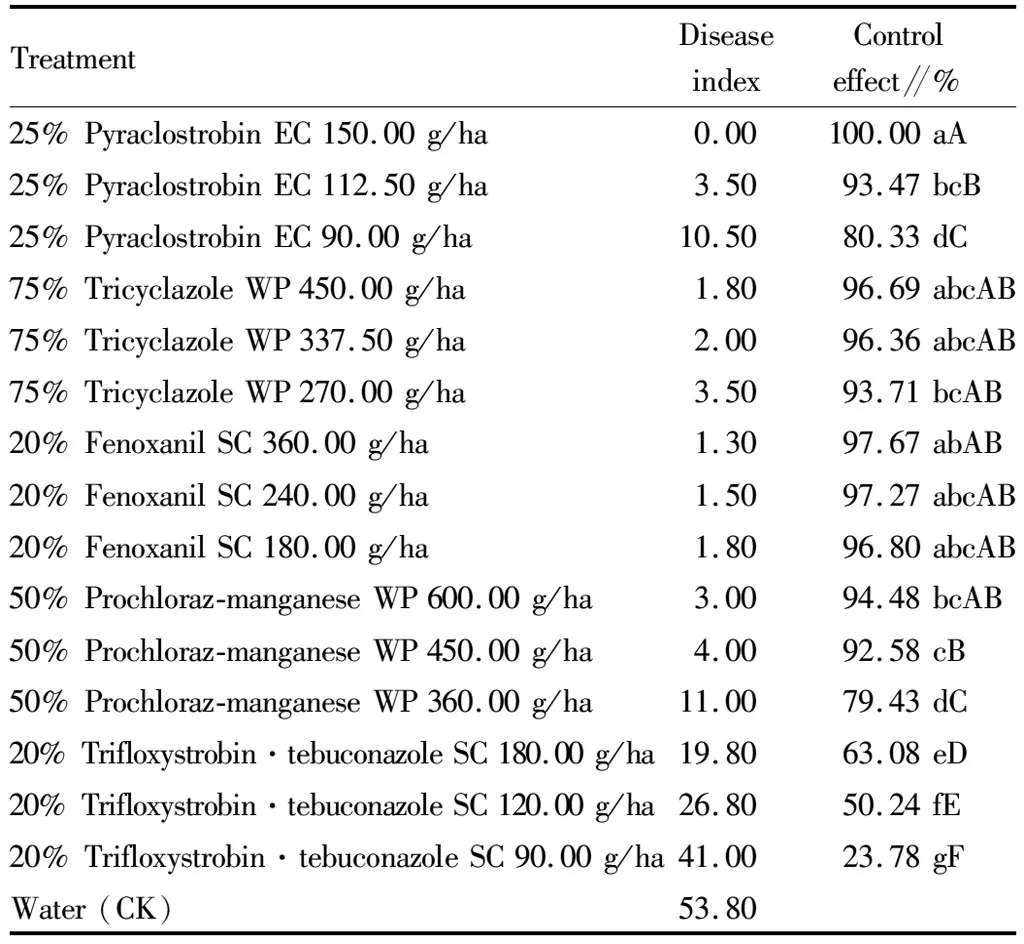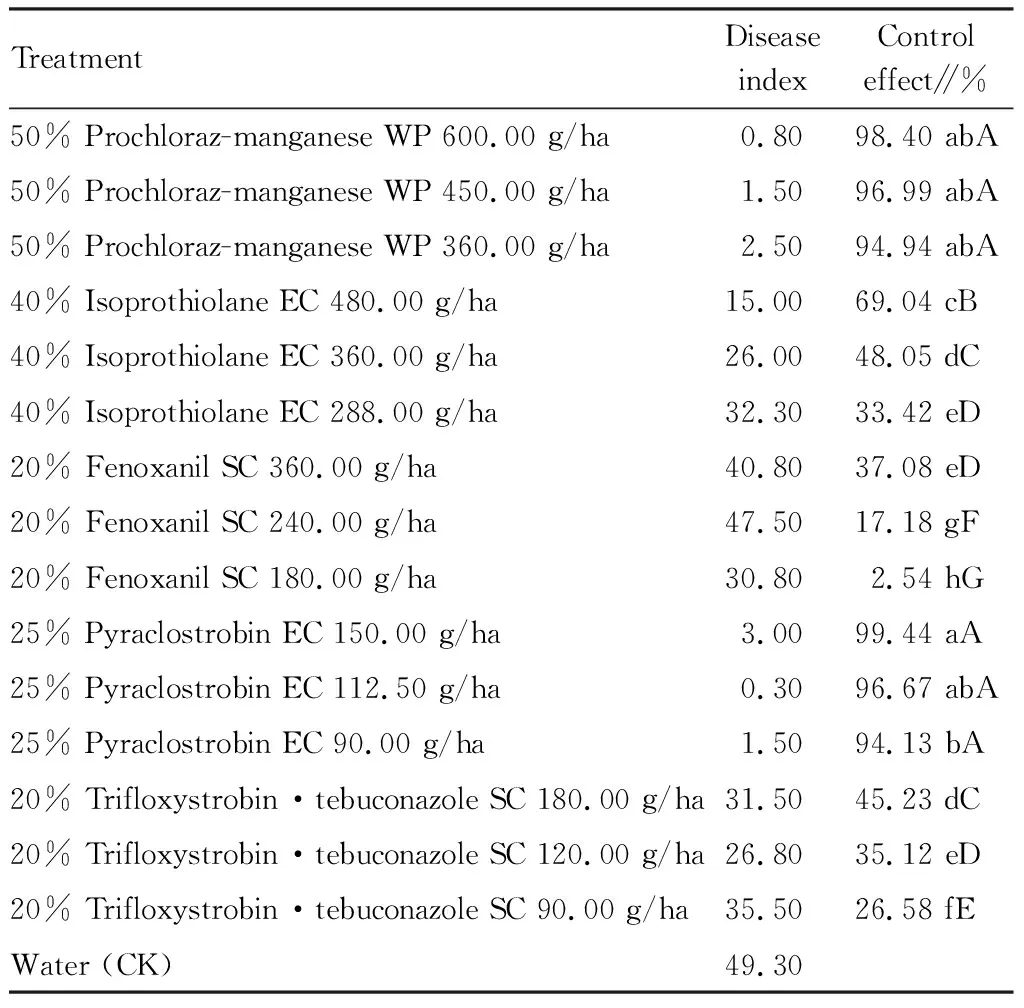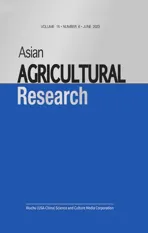Preventive and Therapeutic Effects of New Fungicides on Rice Blast
2023-07-31JinqiFENGAiqingFENGXiaoyuanZHUJianyuanYANGShenCHENJingSU
Jinqi FENG, Aiqing FENG, Xiaoyuan ZHU, Jianyuan YANG, Shen CHEN, Jing SU
Plant Protection Research Institute, Guangdong Academy of Agricultural Sciences, Guangzhou 510640, China
Abstract [Objectives] The paper was to identify the characteristics and the potency of new fungicides to rice blast disease, and study their preventive and therapeutic effects on the disease. [Methods] Six new and conventional fungicides with different mechanisms of action were selected to compare their preventive and therapeutic effects on rice seedling blast in greenhouse. [Results] The agents which showed to be highly efficacious in blast prevention (greater than 90%) were 25% pyraclostrobin EC, 20% fenoxanil SC, 75% tricyclazole WP and 50% prochloraz-manganese WP sprayed at the dosages of 112.5-150, 180-360, 270-450 and 450-600 g/ha, respectively. The therapeutic effect of new fungicides 25% pyraclostrobin EC and 50% prochloraz-manganese WP on rice blast were above 90% when the dosages were 90-150 and 360-600 g/ha, respectively. The therapeutic effect of the conventional fungicide 40% isoprothiolane EC on rice blast was 69.04% when the dosage was 480 g/ha, while those of other fungicides were worse. [Conclusions] Both 25% pyraclostrobin EC and 50% prochloraz-manganese WP have good preventive and therapeutic effects on rice blast, which will provide a reference for the use of these fungicides in the field.
Key words Rice blast, Fungicide, Preventive effect, Therapeutic effect
1 Introduction
Rice is an important food crop in the world. Rice blast (Magnaportheoryzae) is a devastating disease of rice in the world, seriously affecting the yield and quality of rice. Although disease resistance breeding is the most economical and environmentally friendly method for disease control, the complexity and high variability of physiological races ofM.oryzaoften leads to the loss of variety resistance, thus restricting its widespread application. A lot of practice has proved that single use of resistant varieties is not enough to control the occurrence of rice blast[1-2].
Chemical control is still an important prevention and control means against rice blast. With the aggravation of rice blast, the irrational use of chemical agents often leads to a decline in control effect on rice blast. At present, chemical control against rice blast mainly has the following problems. (i) For new fungicides with different mechanisms of action, farmers often abuse them for lack of understanding of their action mode and efficacy. (ii) There are multiple "trade names" for the same fungicide due to different manufacturers and dosage forms, and farmers are often confused in application. (iii) Most chemical control tests against rice blast are field efficacy tests, without laboratory toxicity tests or seedling tests, as well as detailed studies on the preventive and therapeutic effects of fungicides, so farmers often use fungicides blindly. (iv) Long-term use of single fungicide and random increase in drug concentration and dosage have led to serious resistance problems of many highly effective fungicides in some areas, such as isoprothiolane, kitazine, kasugamycin, tricyclazole,etc.[3-12].
In view of the increasing severity of rice blast and the prominent problems of chemical control, we hold that it is necessary to screen a batch of highly effective new preventive and therapeutic fungicides and clarify their mechanisms of action and therapeutic effects, so as to guide farmers to use fungicides scientifically and delay the development of drug resistance. To this end, the author carried out preliminary studies on the preventive and therapeutic effects of six new and conventional fungicides with different mechanisms of action on rice blast, and explored the therapeutic effects and characteristics of various new fungicides on rice blast, so as to provide a reference for the use of these fungicides in the field.
2 Materials and methods
2.1MaterialsThe fungicides used in the test included 50% prochloraz-manganese WP (Bayer CropScience China Co., Ltd.), 75% tricyclazole WP (Dow AgroSciences), 20% fenoxanil SC (Jiangsu Changqing Agrochemical Co., Ltd.), 25% pyraclostrobin EC (BASF), 20% trifloxystrobin·tebuconazole SC (Shenyang Kechuang Chemical Co., Ltd.), and 40% isoprothiolane EC (Zhongnong Zhushang Agricultural Products Co., Ltd.).
The rice variety tested was Guangluai 4, a variety with high susceptibility to rice blast, collected by the rice disease laboratory of Plant Protection Research Institute, Guangdong Academy of Agricultural Sciences.
The strain was isolated from rice blast specimens in Xiangang, Gaoyao City, Guangdong Province in 1998 by the rice disease laboratory of Plant Protection Research Institute, Guangdong Academy of Agricultural Sciences. The strain, No. 98-288, belonged to the physiological race B15.
2.2MethodsBoth preventive and therapeutic tests were indoor pot tests, with 16 treatments for each. The dosage of each treatment is shown in Table 1 and Table 2. Each treatment had 4 pots (replicates), 10-15 plant/pot, and those sprayed with tap water was set as control. Fungicides were sprayed 24 h prior to strain inoculation in preventive test, and were sprayed at 24 h post strain inoculation in therapeutic test. Fungicides and strains were sprayed by the larynx atomizer with compressor at a spraying volume of 900 L/ha. Black and white films were used for moisturizing, heat preservation and light shading treatment within 24 h after spraying strains, and then pots were placed in the greenhouse for moisturizing cultivation at 25-28 ℃ until the rice seedlings were diseased. The disease status was investigated at 10 d.

Table 1 Results of preventive test

Table 2 Results of therapeutic test
The fungicides were sprayed at 21 d post sowing when rice seedlings grew to 4-5 leaf stage, and then the strains were sprayed the next day in preventive test. The results of preventive treatment were investigated 10 d after spraying fungicides. The strains were sprayed at 22 d post sowing in therapeutic test, and then the fungicides were sprayed the next day. The results of therapeutic treatment were investigated 10 d after spraying strains.
2.3SurveymethodsA total of 15 leaves were randomly investigated in each replicate, and a total of 60 leaves were investigated in each treatment to investigate the disease index and calculate the control effect. The grading criteria for disease survey referred to the grading standards for seedling blast released by International Rice Research Institute (IRRI): Grade 0, the plant was healthy without any symptoms; grade 1, there were only pinhead-sized
brown spots on seedling leaves; grade 2, there were large brown spots on seedling leaves; grade 3, there were round to oval gray lesions with brown edges on seedling leaves, about 1-2 mm in diameter; grade 4, there were elliptical or narrowly fusiform lesions confined between two veins, with an area less than 2%; grade 5, there were typical rice blast lesions and the affected leaf area was 2%-10%; grade 6, there were typical rice blast lesions and the affected leaf area was 11%-25%; grade 7, there were typical rice blast lesions and the affected leaf area was 26%-50%; grade 8, there were typical rice blast lesions and the affected leaf area was 51%-75%; grade 9, there were typical rice blast lesions and the affected leaf area was greater than 75%. The calculated formulae are as follows:
Disease index=∑ (Number of diseased leaves at each grade×The value of the representative grade)/(Total number of surveyed leaves×The value of the highest grade)×100
(1)
Control effect=(Disease index in control area-Disease index in treatment area)/Disease index in control area×100%
(2)
The control effects of different treatments were compared by Duncan’s multiple ranger test (DMRT), and all data were processed by Practical Statistical Analysis and Computer Processing Platform (DPS).
3 Results and analysis
3.1PreventivetestagainstseedlingblastAs shown in Table 1, new fungicides 25% pyraclostrobin EC and 50% prochloraz-manganese WP, and conventional fungicides 20% fenoxanil SC and 75% tricyclazole WP had the best preventive effect against rice blast, and the control effects were above 90% when the dosages were 112.5-150, 450-600, 180-360 and 270-450 g/ha, significantly higher than that of other fungicides.
In conclusion, in the early stage or before the occurrence of the disease, 25% pyraclostrobin EC, 20% fenoxanil SC, 75% tricyclazole WP and 50% prochloraz-manganese WP could be used alternately at the dosages of 112.5, 180, 270 and 360 g/ha, which could effectively prevent and control the disease.
3.2TherapeutictestagainstseedlingblastAs shown in Table 2, 25% pyraclostrobin EC and 50% prochloraz-manganese WP had equivalent therapeutic effect on rice blast, and the control effects were above 90% when the dosages were 90-150 and 360-600 g/ha, significantly higher than that of other fungicides. In this study, the control effect of 40% isoprothiolane EC, a traditional therapeutic fungicide, was only 69.04% when the dosage was 480 g/ha, and the effects of other fungicides were not ideal either.
Therefore, 25% pyraclostrobin EC and 50% prochloraz-manganese WP could be used alternately at the dosages of 360 and 90 g/ha to control rice blast, and 40% isoprothiolane EC could also be applied, with a dosage more than 480 g/ha.
4 Conclusions and discussion
The results of preventive and therapeutic tests against rice blast showed that 25% pyraclostrobin EC and 50% prochloraz-manganese WP had better control effect; 75% tricyclazole WP also had a high preventive effect, but 40% isoprothiolane EC had poor preventive and therapeutic effect. Further experimental verification is needed to determine whether the decrease in efficacy is due to the development of drug resistance. 20% Trifloxystrobin·tebuconazole SC had poor preventive and therapeutic effects on rice blast, which was inconsistent with the results reported by Lan Jieetal.[13]that the control effect of 20% trifloxystrobin·tebuconazole SC at the dosage of 100 g/ha was equivalent to that of 75% tricyclazole WP at the dosage of 200 g/ha, and needs to be further tested.
20% Fenoxanil SC had good preventive effect against rice blast, but had poor therapeutic effect. Therefore, the fungicide should be applied before the onset of the disease in production.
The mechanism of action of new fungicides, pyraclostrobin and prochloraz-manganese, is different from that of conventional fungicides, tricyclazole and isoprothiolane. These new fungicides can be used as alternating fungicides of tricyclazole and isoprothiolane, and used alternately in rice blast control. In addition, due to the long-term use of some fungicides in production,M.oryzain some areas have developed resistance to some fungicides[3-12]. Therefore, it is suggested that local governments should formulate rational fungicide rotation rules according to local conditions and guide farmers to use fungicides scientifically, which is of great significance in delaying the development of resistance to new fungicides.
This efficacy test adopted the method of artificial inoculation at seedling stage. On the one hand, more fungicides can be tested in one test. On the other hand, the preventive and therapeutic effects of fungicides can be evaluated more accurately, which has an important reference value for rational application of fungicides.
杂志排行
Asian Agricultural Research的其它文章
- Exploration on the Path of Whole-region Comprehensive Land Consolidation under the Background of Rural Revitalization
- Comparative Analysis of Rice Export Competitiveness in Heilongjiang Province of China Based on Index Method
- Geographical Indication Intellectual Property Protection and Regional Public Brand Construction of Rape Industry in China
- Influencing Factors of Cultivation and Improvement of College Students’ Innovation and Entrepreneurship Ability under the New Normal
- Effects of Different Proportions of Controlled Release Urea and Ordinary Urea on Peanut Yield
- Selection of Greenhouse Zucchini Varieties and High-Quality, High-Yield and High-Efficiency Cultivation Techniques
